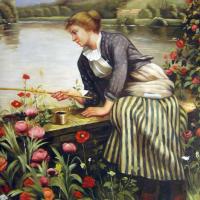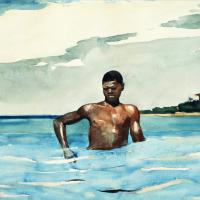Winslow Homer
Winslow Homer
Winslow Homer (February 24, 1836 – September 29, 1910) was an American landscape painter and printmaker, best known for his marine subjects. He is considered one of the foremost painters in 19th-century America and a preeminent figure in American art.
Largely self-taught, Homer began his career working as a commercial illustrator. He subsequently took up oil painting and produced major studio works characterized by the weight and density he exploited from the medium. He also worked extensively in watercolor, creating a fluid and prolific oeuvre, primarily chronicling his working vacations.
Born in Boston, Massachusetts, in 1836, Homer was the second of three sons of Charles Savage Homer and Henrietta Benson Homer, both from long lines of New Englanders. After Homer's high school graduation, his father saw a newspaper advertisement and arranged for an apprenticeship. Homer's apprenticeship at the age of 19 to J. H. Bufford, a Boston commercial lithographer, was a formative but "treadmill experience". He worked repetitively on sheet music covers and other commercial work for two years. By 1857, his freelance career was underway after he turned down an offer to join the staff of Harper's Weekly. Homer's career as an illustrator lasted nearly twenty years. He contributed illustrations of Boston life and rural New England life to magazines such as Ballou's Pictorial and Harper's Weekly at a time when the market for illustrations was growing rapidly and fads and fashions were changing quickly. His quick success was mostly due to this strong understanding of graphic design and also to the adaptability of his designs to wood engraving. Before moving to New York in 1859, Homer lived in Belmont, Massachusetts with his family. His uncle's Belmont mansion, the 1853 Homer House, was the inspiration for a number of his early illustrations and paintings, including several of his 1860s croquet pictures. The Homer House, owned by the Belmont Woman's Club, is open for public tours.
In 1859, he opened a studio in the Tenth Street Studio Building in New York City, the artistic and publishing capital of the United States. Until 1863, he attended classes at the National Academy of Design, and studied briefly with Frédéric Rondel, who taught him the basics of painting. In only about a year of self-training, Homer was producing excellent oil work. His initial sketches were of the camp, commanders, and army of the famous Union officer, Major General George B. McClellan, at the banks of the Potomac River in October 1861. Although the drawings did not get much attention at the time, they mark Homer's expanding skills from illustrator to painter.
Before exhibiting at the National Academy of Design, Homer finally traveled to Paris, France in 1867 where he remained for a year. His most praised early painting, Prisoners from the Front, was on exhibit at the Exposition Universelle in Paris at the same time. He did not study formally but he practiced landscape painting while continuing to work for Harper's, depicting scenes of Parisian life.
Homer painted about a dozen small paintings during the stay. Although he arrived in France at a time of new fashions in art, Homer's main subject for his paintings was peasant life, showing more of an alignment with the established French Barbizon school and the artist Millet than with newer artists Manet and Courbet. Though his interest in depicting natural light parallels that of the early impressionists, there is no evidence of direct influence as he was already a plein-air painter in America and had already evolved a personal style which was much closer to Manet than Monet. Unfortunately, Homer was very private about his personal life and his methods (even denying his first biographer any personal information or commentary), but his stance was clearly one of independence of style and a devotion to American subjects. As his fellow artist Eugene Benson wrote, Homer believed that artists "should never look at pictures" but should "stutter in a language of their own."
Throughout the 1870s, Homer continued painting mostly rural or idyllic scenes of farm life, children playing, and young adults courting, including Country School (1871) and The Morning Bell (1872). In 1875, Homer quit working as a commercial illustrator and vowed to survive on his paintings and watercolors alone. Despite his excellent critical reputation, his finances continued to remain precarious. His popular 1872 painting Snap-the-Whip was exhibited at the 1876 Centennial Exposition in Philadelphia, Pennsylvania, as was one of his finest and most famous paintings Breezing Up (1876).
In 1877, Homer exhibited for the first time at the Boston Art Club with the oil painting, An Afternoon Sun, (owned by the Artist). From 1877 through 1909, Homer exhibited often at the Boston Art Club. Works on paper, both drawings and watercolors, were frequently exhibited by Homer beginning in 1882. A most unusual sculpture by the Artist, Hunter with Dog – Northwoods, was exhibited in 1902. By that year, Homer had switched his primary Gallery from the Boston-based Doll and Richards to the New York City based Knoedler & Co.
Homer started painting with watercolors on a regular basis in 1873 during a summer stay in Gloucester, Massachusetts. From the beginning, his technique was natural, fluid and confident, demonstrating his innate talent for a difficult medium. His impact would be revolutionary. Here, again, the critics were puzzled at first, "A child with an ink bottle could not have done worse." Another critic said that Homer "made a sudden and desperate plunge into water color painting". But his watercolors proved popular and enduring, and sold more readily, improving his financial condition considerably.
As a result of disappointments with women or from some other emotional turmoil, Homer became reclusive in the late 1870s, no longer enjoying urban social life and living instead in Gloucester.
In his last decade, he at times followed the advice he had given a student artist in 1907: "Leave rocks for your old age—they're easy."
Homer died in 1910 at the age of 74 in his Prouts Neck studio and was interred in the Mount Auburn Cemetery in Cambridge, Massachusetts. His painting, Shooting the Rapids, Saguenay River, remains unfinished.
His Prouts Neck studio, a National Historic Landmark, is now owned by the Portland Museum of Art, which offers tours.
In 1962, the U.S. Post Office released a commemorative stamp honoring Winslow Homer. Homer's famous oil painting Breezing Up, now hanging in the National Gallery in Washington DC, was chosen as the image for the design of this issue. On August 12, 2010, The Postal Service issued a 44-cent commemorative stamp featuring Homer's Boys in a Pasture at the APS Stamp Show in Richmond, Virginia. This stamp was the ninth to be issued in a series entitled "American Treasures". The original painting is part of the Hayden Collection at the Museum of Fine Arts in Boston. It depicts two boys from Belmont, Massachusetts—John Carney and Patrick Keenan—who posed for the artist for 75 cents per day.







